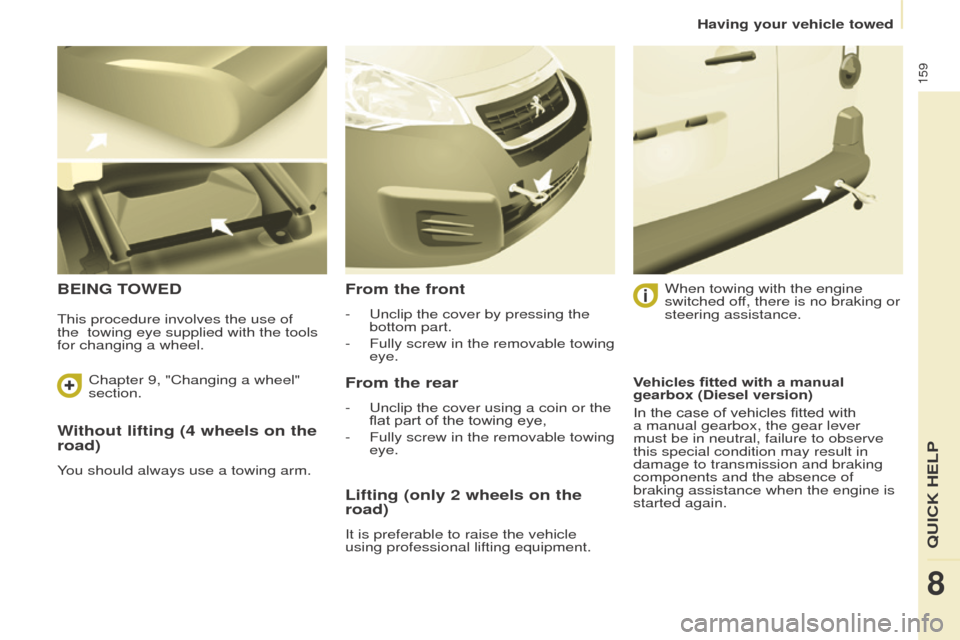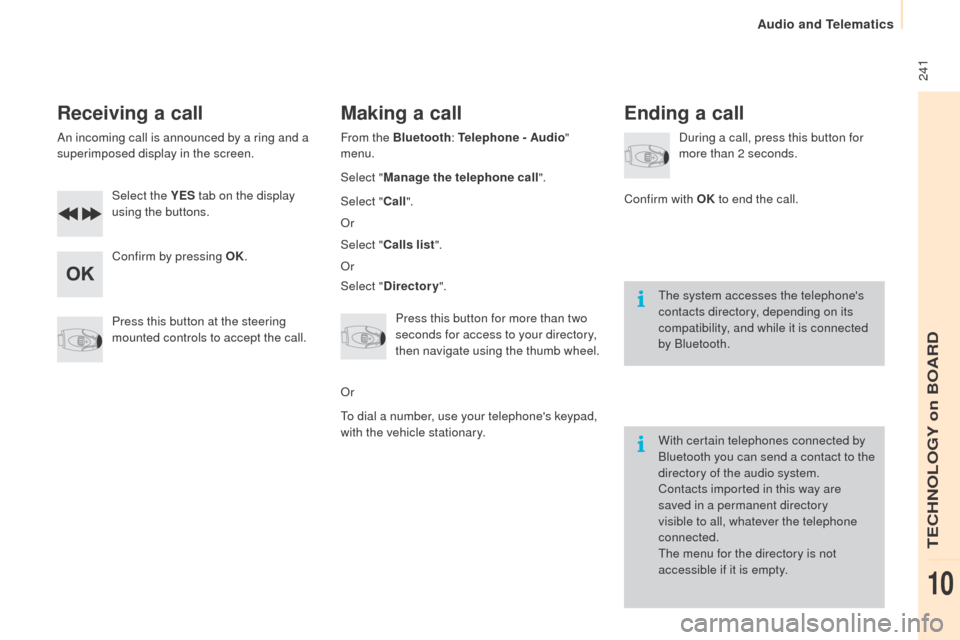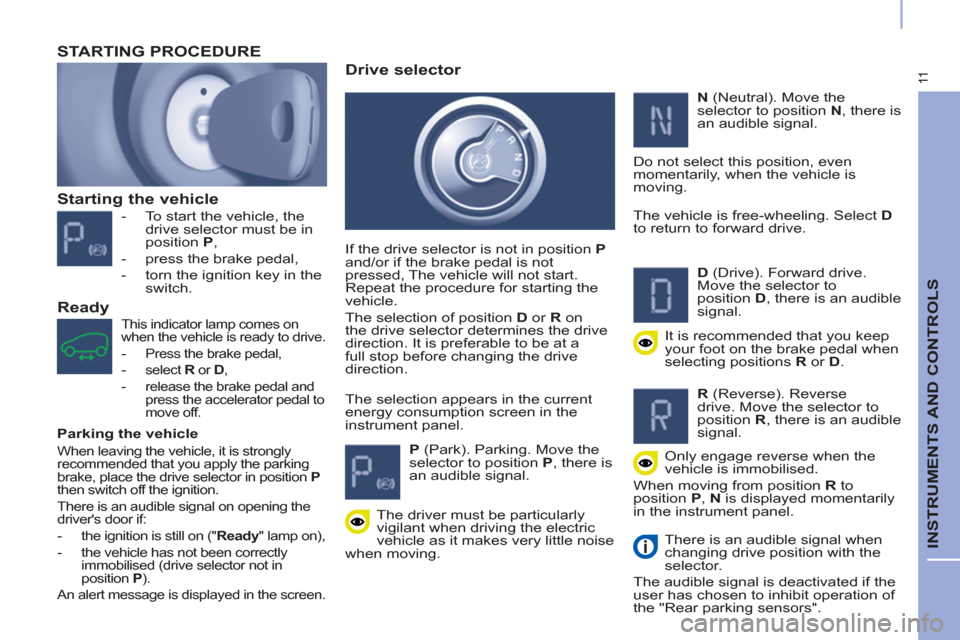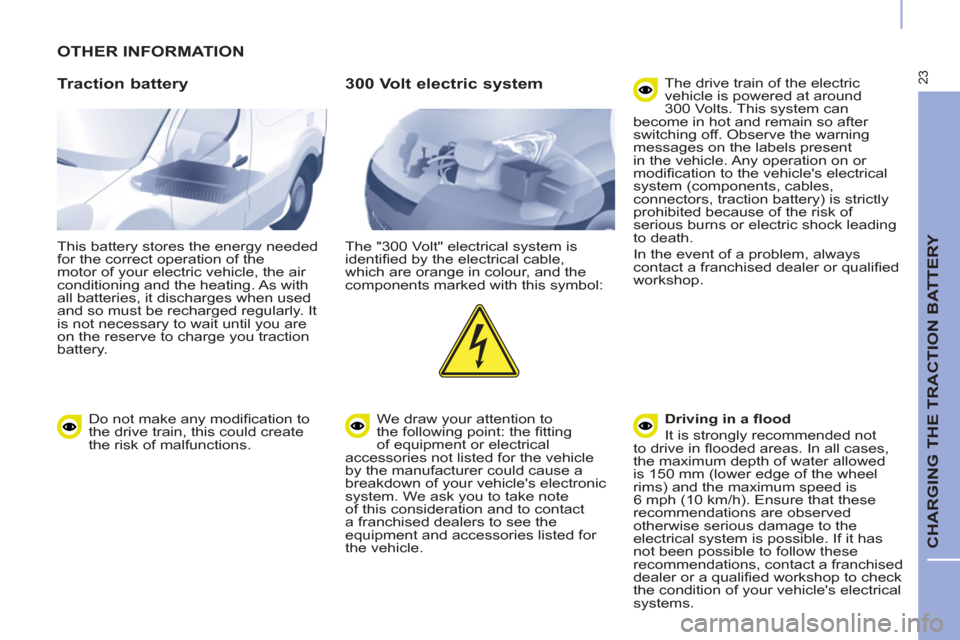Page 159 of 292
157
Partner-2-VU_en_Chap08_Aide-rapide_ed01-2015
Fuses under the bonnet
After opening the bonnet, unclip and tilt
the box to gain access to the fuses.Fuses
F Amperes
A Allocation
1 20 Engine management
2 15 Horn
3 10 Front and rear screenwash pump
4 20 Headlamp wash pump or LED
5 15 Engine components
6 10 Steering wheel angle sensor, DSC
7 10 Brake switch, clutch switch
8 25 Starter motor
9 10 Headlamp beam motor, parc management
unit
10 30 Engine components 11 40 Not used
12 30 Wipers
13 40 Built-in systems interface
14 30 Pump
15 10 Right-hand main beam headlamp
16 10 Left-hand main beam headlamp
17 15 Right-hand dipped beam headlamp
18 15 Left-hand dipped beam headlamp
Changing a fuse
QUICK HELP
8
Page 161 of 292

159
Partner-2-VU_en_Chap08_Aide-rapide_ed01-2015
Without lifting (4 wheels on the
road)
You should always use a towing arm.
BEING TOWEDFrom the front
- Unclip the cover by pressing the
bottom part.
-
Fully screw in the removable towing
eye.
From the rear
- Unclip the cover using a coin or the
flat part of the towing eye,
-
Fully screw in the removable towing
eye. When towing with the engine
switched of
f, there is no braking or
steering assistance.
Lifting (only 2 wheels on the
road)
It is preferable to raise the vehicle
using professional lifting equipment.
This procedure involves the use of
the
towing eye supplied with the tools
for changing a wheel.
Vehicles fitted with a manual
gearbox (Diesel version)
In the case of vehicles fitted with
a manual gearbox, the gear lever
must be in neutral, failure to observe
this special condition may result in
damage to transmission and braking
components and the absence of
braking assistance when the engine is
started again.
Chapter 9, "Changing a wheel"
section.
Having your vehicle towed
QUICK HELP
8
Page 165 of 292
163
Partner-2-VU_en_Chap09_Caract-technique_ed01-2015
Short - L1Long - L2
625 850750
L Overall length 43804628
H Overall height 1805-1834
A Wheelbase 2728
B Front overhang 925
C Rear overhang 727975
D Width over panels: without mirrors
1810
with mirrors 2112
E Width of front track 1505
F Width of rear track 1554
G Useable rear floor length 18002050
I Useable length with front passenger seat
folded 3000
3250
DIMENSIONSV
an (mm)
The vehicle is available in 2 lengths (L1 and L2),
refer to the tables.
Dimensions
TECHNICAL DATA
9
Page 168 of 292
166
Partner-2-VU_en_Chap09_Caract-technique_ed01-2015
L Overall length4237
H Overall height 1821-1822
A Wheelbase 2728
B Front overhang 925
C Rear overhang 584
D Width over panels (without mirrors) 1810
E Width of front track 1505
F Width of rear track 1554
Floor cab (mm)
Dimensions
Page 170 of 292
168
Partner-2-VU_en_Chap09_Caract-technique_ed01-2015
IDENTIFICATION MARKINGS
A. Manufacturer's plate.C. Tyres and paint colour code.
B. Serial number.
This is located on the right-hand
middle pillar.
1 - VF Type serial number.
2 - Gross vehicle weight (GVW).
3 - Gross train weight (GTW).
4.1 - Maximum weight on front axle.
4.2 - Maximum weight on rear axle. This is engraved on the front right
wheelarch.
The label C, on the front door gives:
-
the wheel and tyre sizes,
-
the tyre pressures, laden and
unladen
-
the tyre pressure for the spare
wheel,
-
the paint colour code.The tyre pressures should be
checked when the tyres are cold,
at least once a month.
Identification markings
Page 243 of 292

241
Partner-2-VU_en_Chap10b_RD45_ed01-2015
Receiving a call
An incoming call is announced by a ring and a
superimposed display in the screen.Select the YES tab on the display
using the buttons.
Confirm by pressing OK.
Press this button at the steering
mounted controls to accept the call.
Making a call
From the Bluetooth : Telephone - Audio "
menu.
Select " Manage the telephone call".
Select " Call".
Or
Select " Calls list ".
Or
Select " Directory ".
Press this button for more than two
seconds for access to your directory,
then navigate using the thumb wheel.
Or
To dial a number, use your telephone's keypad,
with the vehicle stationary.
Ending a call
During a call, press this button for
more than 2 seconds.
Confirm with OK to end the call.
The system accesses the telephone's
contacts directory, depending on its
compatibility, and while it is connected
by Bluetooth.
With certain telephones connected by
Bluetooth you can send a contact to the
directory of the audio system.
Contacts imported in this way are
saved in a permanent directory
visible to all, whatever the telephone
connected.
The menu for the directory is not
accessible if it is empty.
TECHNOLOGY on BOARD
10
Audio and Telematics
Page 269 of 292

11
INSTRUMENTS AND CONTROLS
Starting the vehicle
- To start the vehicle, the
drive selector must be in
position P
,
- press the brake pedal,
- torn the ignition key in the
switch.
STARTING PROCEDURE
This indicator lamp comes on
when the vehicle is ready to drive.
-
Press the brake pedal,
-
select R
or D
,
-
release the brake pedal and
press the accelerator pedal to
move off.
The selection appears in the current
energy consumption screen in the
instrument panel.
Drive selector
If the drive selector is not in position P
and/or if the brake pedal is not
pressed, The vehicle will not start.
Repeat the procedure for starting the
vehicle.
The selection of position D
or R
on
the drive selector determines the drive
direction. It is preferable to be at a
full stop before changing the drive
direction.
P
(Park). Parking. Move the
selector to position P
, there is
an audible signal.
N
(Neutral). Move the
selector to position N
, there is
an audible signal.
Do not select this position, even
momentarily, when the vehicle is
moving.
The vehicle is free-wheeling. Select D
to return to forward drive.
D
(Drive). Forward drive.
Move the selector to
position D
, there is an audible
signal.
It is recommended that you keep
your foot on the brake pedal when
selecting positions R
or D
.
R
(Reverse). Reverse
drive. Move the selector to
position R
, there is an audible
signal.
Only engage reverse when the
vehicle is immobilised.
When moving from position R
to
position P
, N
is displayed momentarily
in the instrument panel.
There is an audible signal when
changing drive position with the
selector.
The audible signal is deactivated if the
user has chosen to inhibit operation of
the "Rear parking sensors".
The driver must be particularly
vigilant when driving the electric
vehicle as it makes very little noise
when moving.
Ready
Parking the vehicle
When leaving the vehicle, it is strongly
recommended that you apply the parking
brake, place the drive selector in position P
then switch off the ignition.
There is an audible signal on opening the
driver's door if:
-
the ignition is still on (" Ready
" lamp on),
-
the vehicle has not been correctly
immobilised (drive selector not in
position P
).
An alert message is displayed in the screen.
Page 281 of 292

23
CHARGING THE TRACTION BATTERY
OTHER INFORMATION
Traction battery
This battery stores the energy needed
for the correct operation of the
motor of your electric vehicle, the air
conditioning and the heating. As with
all batteries, it discharges when used
and so must be recharged regularly. It
is not necessary to wait until you are
on the reserve to charge you traction
battery.
300 Volt electric system
The "300 Volt" electrical system is
identifi ed by the electrical cable,
which are orange in colour, and the
components marked with this symbol:
We draw your attention to
the following point: the fi tting
of equipment or electrical
accessories not listed for the vehicle
by the manufacturer could cause a
breakdown of your vehicle's electronic
system. We ask you to take note
of this consideration and to contact
a franchised dealers to see the
equipment and accessories listed for
the vehicle. The drive train of the electric
vehicle is powered at around
300 Volts. This system can
become in hot and remain so after
switching off. Observe the warning
messages on the labels present
in the vehicle. Any operation on or
modifi cation to the vehicle's electrical
system (components, cables,
connectors, traction battery) is strictly
prohibited because of the risk of
serious burns or electric shock leading
to death.
In the event of a problem, always
contact a franchised dealer or qualifi ed
workshop.
Driving in a fl ood
It is strongly recommended not
to drive in fl ooded areas. In all cases,
the maximum depth of water allowed
is 150 mm (lower edge of the wheel
rims) and the maximum speed is
6 mph (10 km/h). Ensure that these
recommendations are observed
otherwise serious damage to the
electrical system is possible. If it has
not been possible to follow these
recommendations, contact a franchised
dealer or a qualifi ed workshop to check
the condition of your vehicle's electrical
systems.
Do not make any modifi cation to
the drive train, this could create
the risk of malfunctions.